In a new question in the Wave 43 survey, suggested by Wave 42 participants, respondents were asked how their organizations’ property insurance and professional liability insurance have changed, as compared with before the pandemic started. Across all care segments – independent living, assisted living, memory care, and nursing care – about 50% indicated their professional liability insurance has increased slightly, with an additional 30% of nursing care respondents indicating it has increased significantly. The findings are similar for property insurance, with approximately 50% indicating property insurance has increased slightly and between one-quarter and one-third indicating property insurance has increased significantly. Among the reasons cited for the increases are lack of competition in local markets, COVID concerns and litigation, increased frequency of natural disasters, and a nationwide increase in frequency and severity of claims.
--Ryan Brooks, Senior Principal, NIC
NIC’s Executive Survey of senior housing and skilled nursing operators was implemented in March 2020 to deliver real-time insights into the impact of the pandemic and the pace of recovery. In its third year, the “ESI” is transitioning away from the COVID-19 crisis to focus on timely industry topics. While some standard questions will remain for tracking purposes, in each new survey "wave," new questions are added.
This Wave 43 survey includes responses from June 27 to July 24, 2022, from owners and executives of 50 small, medium, and large senior housing and skilled nursing operators across the nation, representing hundreds of buildings and thousands of units across respondents’ portfolios of properties. More detailed reports for each “wave” of the survey and a PDF of the report charts can be found on the NIC COVID-19 Resource Center webpage under Executive Survey Insights.
Across 43 Waves of the ESI, the pace of move-ins has closely corresponded with the broad incidence of COVID-19 infection cases in the United States. This is demonstrated in the timeline below that shows the share of organizations reporting an increase in the pace of move-ins during the prior 30-days. Data from Waves 42 and 43, conducted between May 31 and July 24, 2022, indicates a decrease in the share of operators reporting an acceleration in the pace of move-ins. This time period coincides with the highly transmissible BA.4 and BA.5 subvariants emerging as the dominant strains in the United States.
Of respondents indicating a deceleration in the pace of move-ins, 76% indicate the deceleration is a result of a slowdown in leads conversions/sales, 18% report the deceleration is a result of an organizationally imposed ban, and 6% indicate resident or family member concerns as the driving factor. There were no reports of staffing shortages driving the deceleration in pace of move-ins, as compared to 16% of respondents in the Wave 42 survey conducted in June 2022.
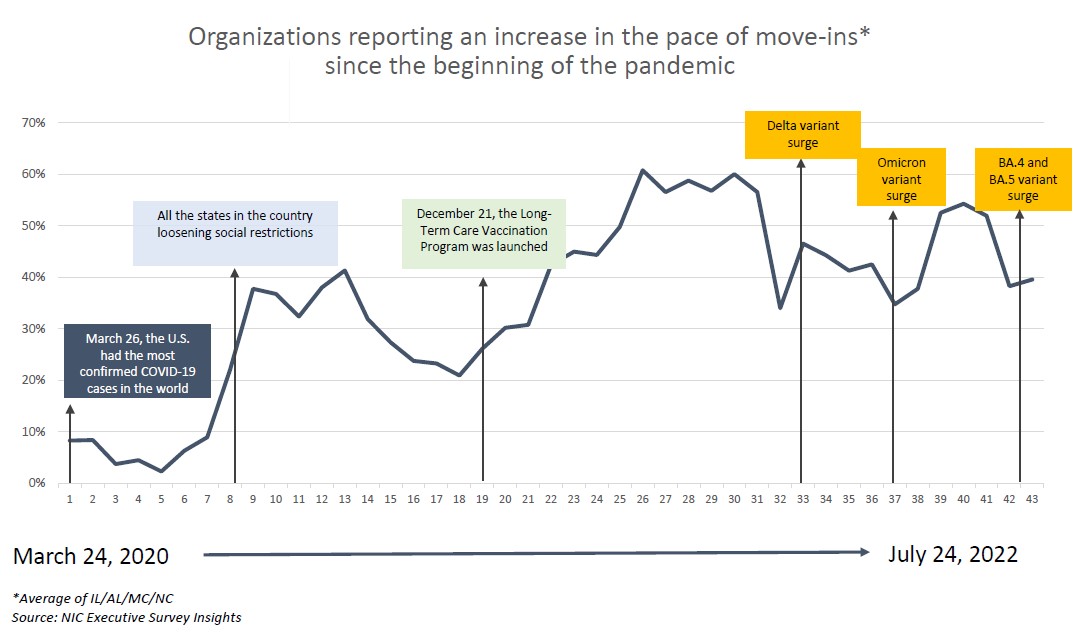
In the Wave 43 survey, reflecting operator experiences in July 2022, the pace of move-ins in the past 30 days remained steady for assisted living residences (50%), but declined for independent living residences (31%) and nursing care residences (29%). For nursing care operators, this marks the second consecutive wave where the shares of organizations reporting an acceleration in the pace of move-ins has decreased from the prior wave, down from 68% in Wave 41 and 37% in Wave 42. Conversely, it is also the second consecutive wave where the shares of organizations reporting a deceleration in the pace of move-ins increased, up from 7% in Wave 41 and 17% in Wave 42. Interestingly, with 48% of respondents reporting a decrease in the pace of move-ins, memory care properties rebounded from the significant decrease that was experienced in Wave 42.
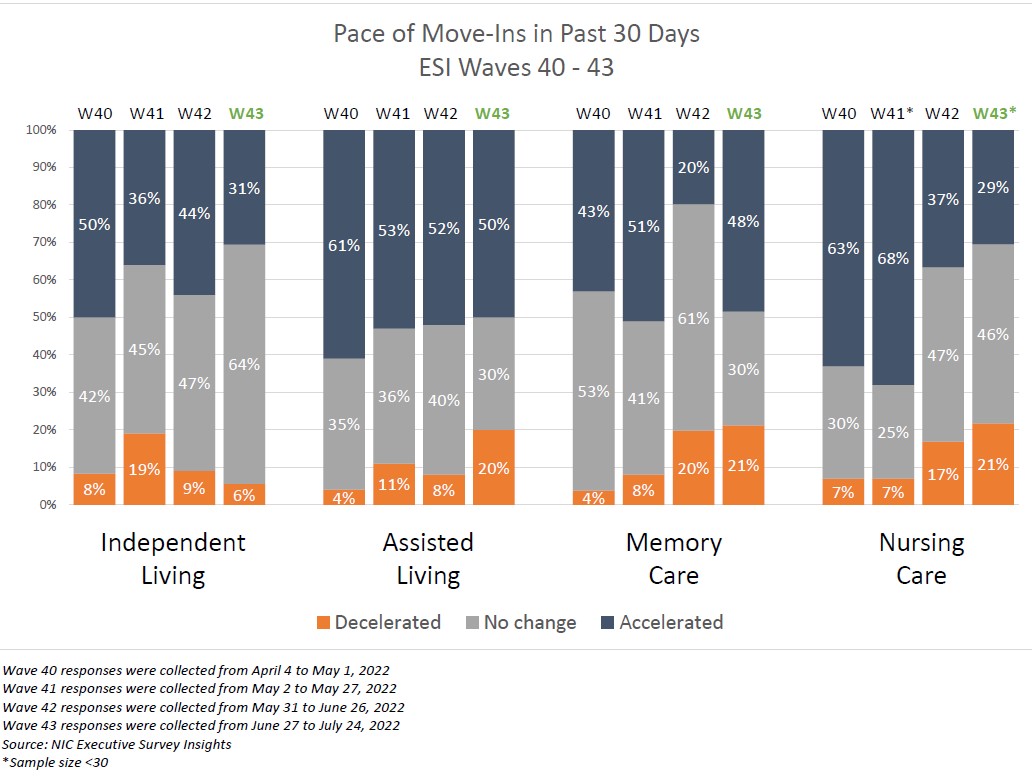
As it pertains to the pace of move-outs, most survey respondents across all care segments reported no change in the pace of move-outs within the past 30 days, a consistent theme across the most recent four ESI Waves. In Wave 43, 77% of independent living operators, 74% of assisted living, 63% of memory care, and 58% of nursing care operators reported no change in the pace of their move-outs.
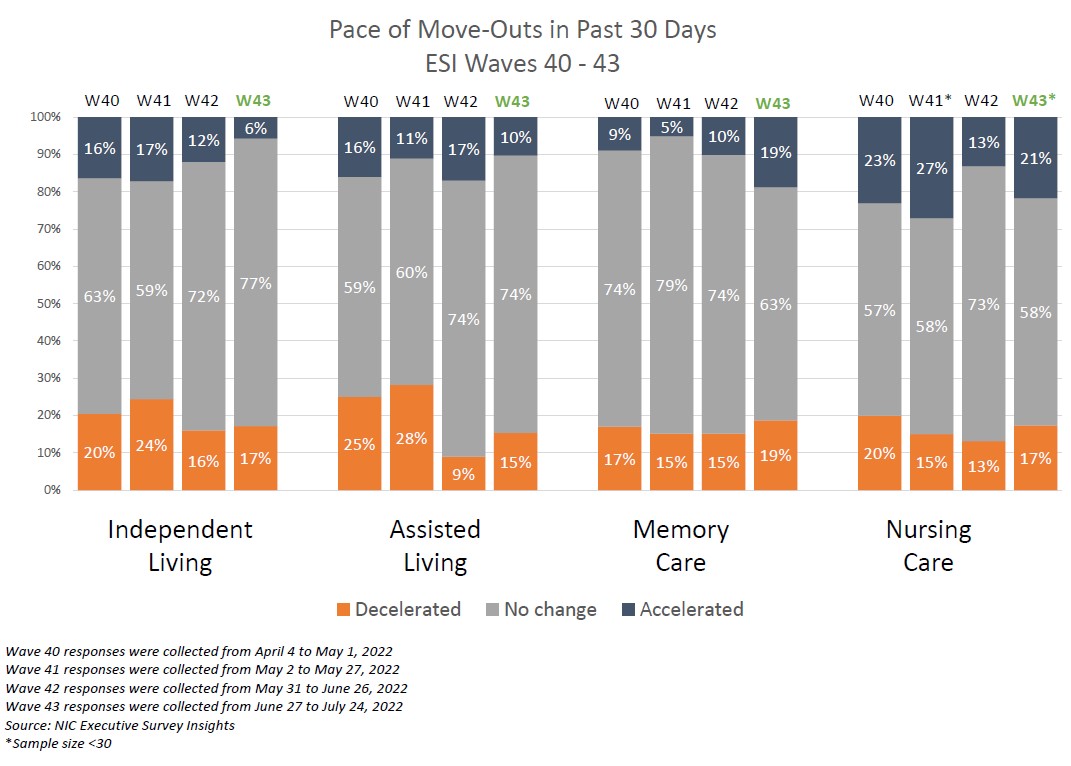
Property and professional liability insurance premiums have increased for the vast majority of respondents. In a new question in the Wave 43 survey, suggested by Wave 42 respondents, respondents were asked how their organization’s property and professional liability insurance have changed, as compared to before the pandemic started. Approximately half of respondents – across all care segments – indicate that their property insurance premiums have increased slightly. Roughly 24% of independent living, 32% of assisted living, 25% of memory care, and 27% of nursing care respondents answered that their property insurance has increased significantly. Only 6% of independent living, and 3% of assisted living and memory care operators reported a decline in property insurance premiums. When asked why premiums have increased, survey respondents indicate COVID litigation, increases in fire insurance, inflation on replacement costs, and insurance companies leaving the market resulting in a lack of competition from carriers in certain markets.

When asked how their organization’s professional liability insurance has changed, approximately 50% of Wave 43 respondents indicated their professional liability insurance premiums have increased slightly. Additionally, 14% of independent living, 26% of assisted living, 19% of memory care, and 30% of nursing care report that their professional liability insurance premiums have increased significantly, as compared to the pre-pandemic period. Only 3% of independent living respondents indicated a slight decrease in professional liability premiums. For assisted living, memory care, and nursing care, there were no responses indicating a decrease in professional liability premiums. Among the reasons cited for the increase in professional liability premiums were a nationwide increase in claims frequency and severity, a perceived risk associated with COVID-19 deaths, inflation, cost of care, and fewer carriers resulting in less competition.
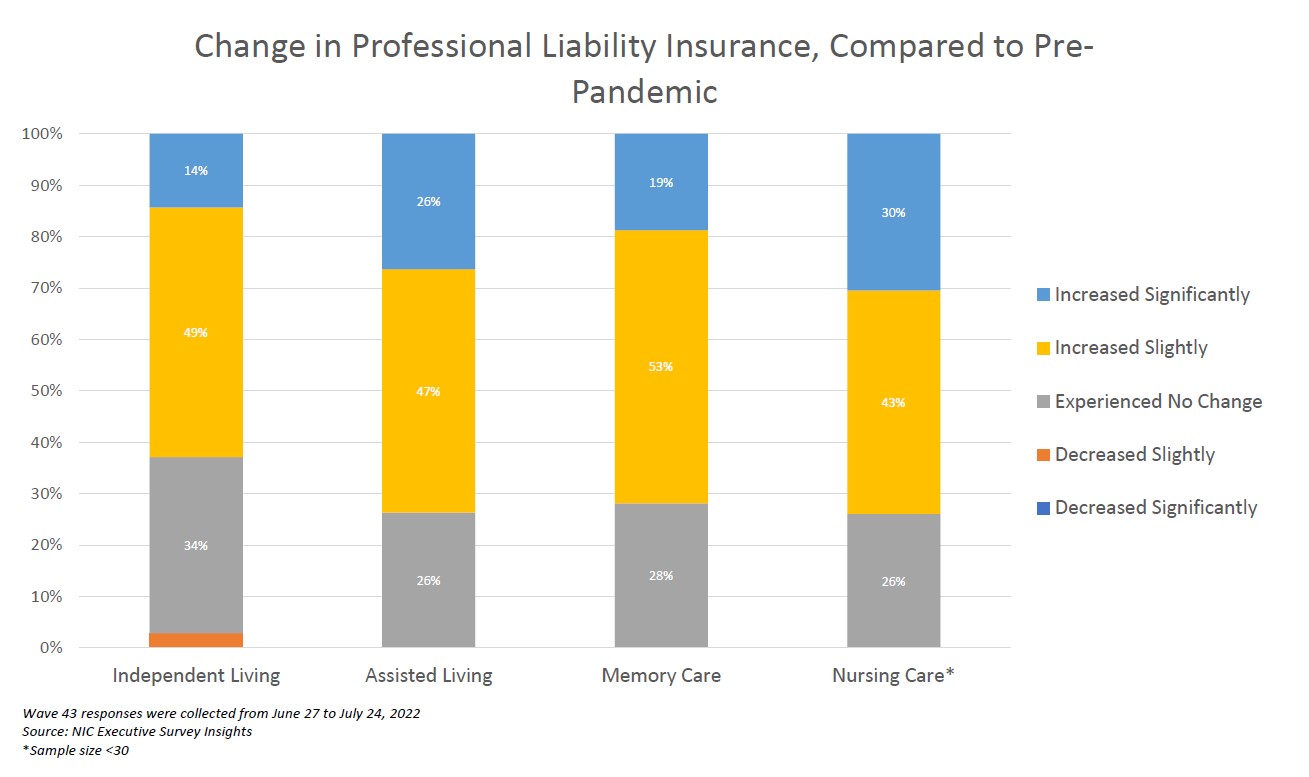
The Wave 43 survey asked respondents whether they found the acuity of new resident move-ins to have increased, decreased, or stayed the same as compared to before the pandemic started. Increased move-in acuity, compared to pre-pandemic acuity, was reported by 66% of the respondents for assisted living, 56% in memory care, and 64% in nursing care. Only 36% of independent living reported increased resident acuity at move-in.
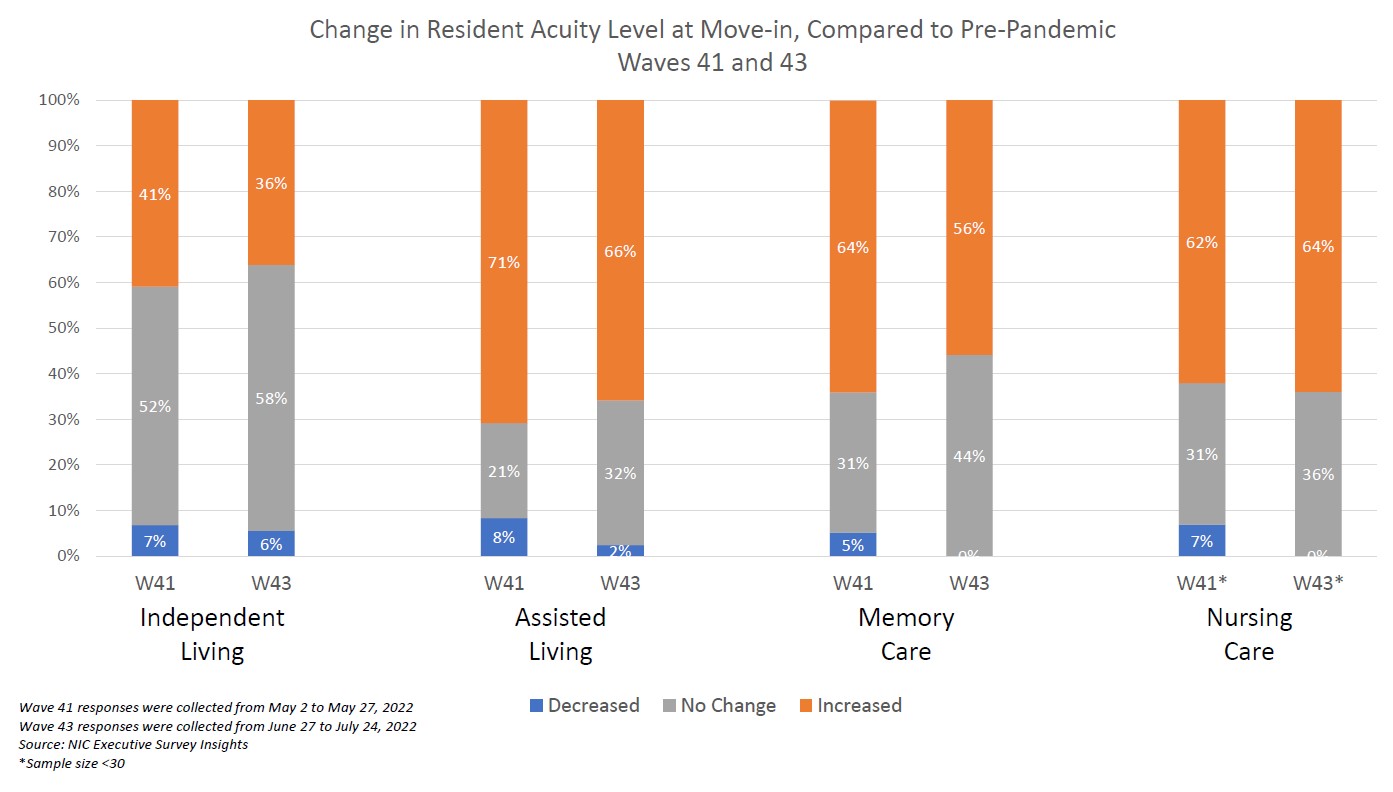
Wave 43 Survey Demographics
- Responses were collected between June 27 and July 24, 2022, from owners and executives of 50 senior housing and skilled nursing operators across the nation. Owners/operators with 1 to 10 properties comprise roughly two-thirds (67%) of the sample. Operators with 11 to 25 properties account for 20%, and operators with 26 properties or more make up the rest of the sample with 13%.
- One-half of respondents are exclusively for-profit providers (52%), approximately one-third operate not-for-profit seniors housing and care properties (38%), and 10% operate both.
- Many respondents in the sample report operating combinations of property types. Across their entire portfolios of properties, 70% of the organizations operate seniors housing properties (IL, AL, MC), 23% operate nursing care properties, and 36% operate CCRCs – also known as life plan communities.
Owners and C-suite executives of seniors housing and care properties, please help us tell an accurate story about our industry’s performance. If you are an owner or C-suite executive of seniors housing and care and have not received an email invitation to take the survey, please contact Ryan Brooks at rbrooks@nic.org to be added to the list of recipients.
NIC wishes to thank respondents for their valuable input and continuing support for this effort to provide the broader market with a sense of the evolving landscape as we recover from the pandemic. This is your survey! Please take the Wave 44 survey and suggest new questions for Wave 45.
About Ryan Brooks
Senior Principal Ryan Brooks works with the research team in providing research, analysis, and contributions in the areas of healthcare collaboration and partnerships, telemedicine implementation, EHR optimization, and value-based care transition. Prior to joining NIC, he served as Clinical Administrator for multiple service lines within the Johns Hopkins Health System, where he focused on patient throughput strategies, regulatory compliance, and lean deployment throughout the organization. Brooks received his Bachelor’s in Health Services Administration from James Madison University and his Master’s in Business Administration from the University of Maryland.
Connect with Ryan Brooks
Read More by Ryan Brooks